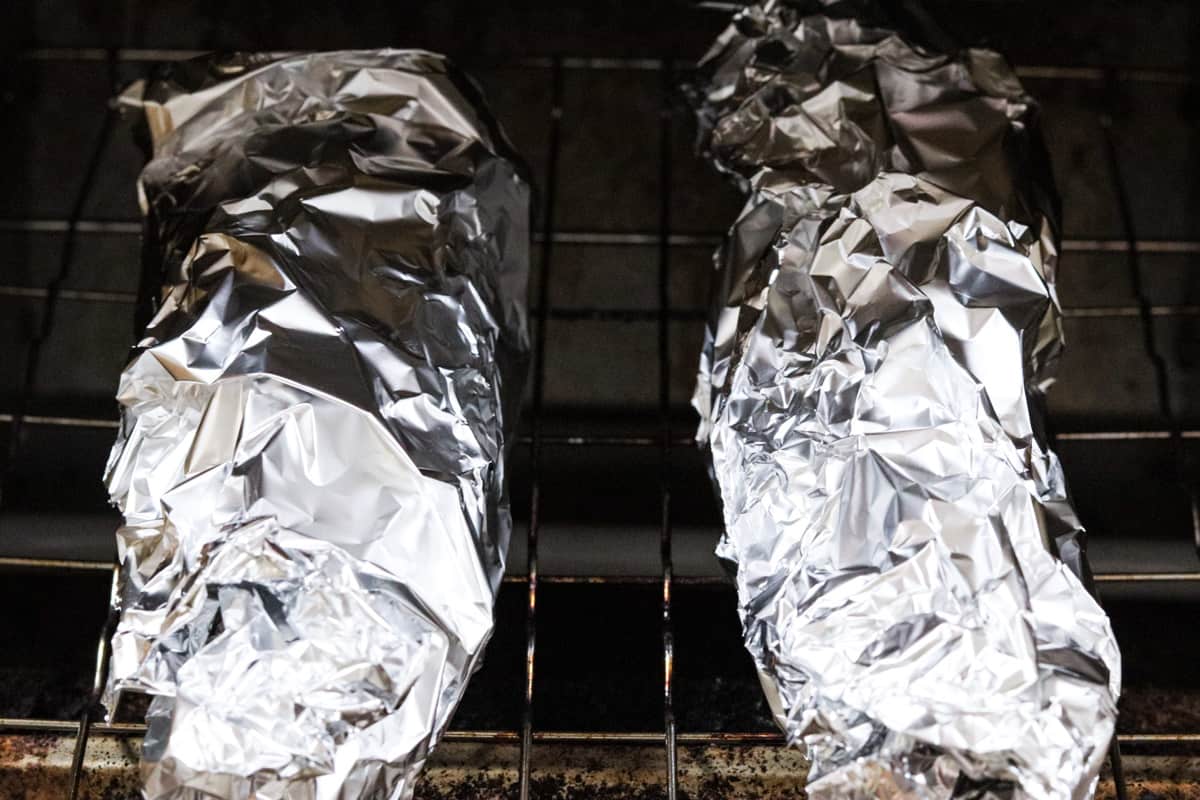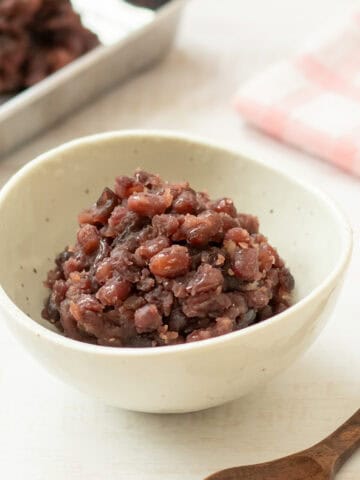Yaki Imo is a Japanese sweet snack typically enjoyed from autumn through winter. When you split a freshly baked one in half, steam rises, and the natural, rich sweetness of the Japanese sweet potato fills your mouth with each bite.

Jump to:
What is Yaki Imo?
Yaki Imo is a sweet snack made by baking Japanese sweet potatoes. "Yaki" means to bake, and "Imo" refers to potatoes. The potatoes used in this snack are Japanese sweet potatoes, also known as satsumaimo. By slowly baking the sweet potatoes over time, their flavor is sealed inside the skin, resulting in a rich sweetness.
In Japan, it has been enjoyed for centuries and is a staple snack commonly found in grocery stores and on mobile food trucks during the fall and winter months. Japanese sweet potatoes vary significantly in taste and texture depending on the variety, so if you have a choice, I highly recommend trying different ones to enjoy their distinct flavors.

Japanese sweet potato varieties
In Japan, there are currently around 60 different varieties of sweet potatoes being cultivated. Below, I have listed some of the popular representative varieties in Japan.
- Beni-Azuma (紅あずま): Known for its mild sweetness, this is one of the traditional sweet potato varieties that is most widely consumed in eastern Japan.
- Naruto-Kintoki (鳴門金時): This variety also offers mild sweetness and is most commonly found in western Japan as a traditional sweet potato.
- Anno-Imo (安納芋): With its slightly orange flesh and intensely sweet, creamy texture, it is considered a representative sweet potato with high sweetness in Japan.
- Beni-Haruka (紅はるか): Characterized by its intensely sweet and creamy texture, it has been a leading variety since its introduction in 2010, contributing to the yaki imo craze in Japan.
- Silk Sweet (シルクスイート): This variety is also renowned for its sweet and creamy texture. However, it tends to be slightly less sweet and creamy compared to Anno-Imo and Beni-Haruka.
While you can make yaki imo with any type of Japanese sweet potatoes, if you have the opportunity, I highly recommend trying Anno-Imo or Beni-Haruka. When properly cooked, it is said that yaki imo made from these varieties can reach a sugar content of 50-60 Brix.
How to choose delicious Japanese sweet potatoes
When purchasing Japanese sweet potatoes, choose the best ones available. You can assess their quality based on the following appearance factors:
• They should have black, soil-like markings on the surface.
These dark spots are the result of the white liquid called 'yarapin' that oozes out of the sweet potato and oxidizes. Yarapin emerges from sweet potatoes with a high sugar content, indicating the potential for sweetness. They should have a glossy appearance, be slightly firm to the touch, and feel a little sticky. Be careful not to mistake them for mold or black spot disease.
• Avoid overly large ones.
Sweet potatoes that are too large have less sweetness and can become difficult to cook through. A weight of 7-9 ounces (200-250 g) is optimal for yaki imo. Smaller ones will also taste good. To ensure even cooking, it is recommended to choose sweet potatoes with consistent thickness.
Even if they are the same size, their weight may differ. In such cases, it is recommended to choose the heavier one, as Lighter sweet potatoes may have less dense flesh.

In Japan, sweet potatoes are typically harvested from around September to November, but they become sweeter and more delicious after an aging period of approximately 2-3 months after harvest. Therefore, Japanese sweet potatoes available from December to February are the best for consumption.
The key to making yaki imo more delicious
To create delicious yaki imo, there are four key tips to keep in mind: the 'gelatinization' and 'saccharification' of starch, the 'softening' of pectin, and the 'concentration' achieved through high-temperature heating.
The reason Japanese sweet potatoes become sweet when baked is that their components undergo a transformation. The starch in sweet potatoes softens when heated (gelatinization), and the β-amylase, also found in sweet potatoes, converts the softened starch into maltose (saccharification).
Depending on the variety of Japanese sweet potatoes, the temperature at which starch begins to soften is generally 158-176℉ (70-80℃), and the temperature at which β-amylase becomes active is usually 149-167℉ (65-75℃). Based on these facts, sweet potatoes become sweeter when they are heated slowly over a long period at a low temperature of 158-167℉ (70-75℃).
However, there is a drawback to heating them at 158-167℉ (70-75℃): yaki imo will have a dry texture. This is because the pectin contained in sweet potatoes doesn't soften at these temperatures. Pectin acts as the binder that holds cells together and can either soften or harden with heat. Since pectin hardens in the temperature range of 140-176℉ (60-80℃), sweet potatoes need to be heated at least 176℉ (80℃) or higher to achieve a moist and creamy texture.
In other words, simply heating sweet potatoes doesn't simultaneously achieve both sweetness through the 'gelatinization and saccharification' of starch and a creamy texture through the 'softening' of pectin.
Therefore, I recommend initially baking the sweet potatoes at 482℉ (250℃) for 30 minutes and then allowing them to rest in residual heat for 90 minutes. Baking them at 482℉ (250℃) helps soften the pectin during the baking process, resulting in a moist, creamy texture for your yaki imo. As the sweet potatoes cool down during the residual heat, their natural sweetness is brought out.
Finally, bake them once more at 482℉ (250℃) for an additional 30 minutes. This process allows the moisture to evaporate from the gelatinized sweet potatoes, concentrating the flavors and providing a sweeter taste.
The above I describe is a method for creating the ideal yaki imo that takes time to make. If you prioritize saving time and don't mind sacrificing some flavor and texture, you can make yaki imo by simply baking sweet potatoes at 392℉ (200℃) for about 40 minutes. Depending on your priorities, you can adjust the cooking method accordingly.
Tips for better flavor and texture
When making yaki imo, taking extra steps in the preparation of sweet potatoes allows you to experience their flavor and texture more fully.
The first step is to soak the sweet potatoes in salted water beforehand. By doing this, you will taste the sweetness of the sweet potatoes more when baking, due to the contrast in flavors. There is no need to wipe off the water before baking.
The second step is to wrap the sweet potatoes in aluminum foil while baking. Instead of tightly wrapping each sweet potato in aluminum foil, gently wrap each one, leaving some space between the sweet potatoes and the foil. This allows the sweet potatoes to bake more evenly.
Cookware recommendations
You can make yaki imo using various methods such as an oven, a toaster oven, or a frying pan. However, I highly recommend using an oven or a toaster oven because they allow for easier temperature control, enabling you to cook at the two different temperatures mentioned above.
Please note that when using a toaster oven, since it doesn't retain residual heat like an oven, you need to heat it at 212℉ (100℃) for 90 minutes instead. The reason for using a slightly higher temperature than the optimal temperature for maximizing sweetness is to reach an internal temperature of the sweet potato of about 158-167℉ (70-75℃).
When using a frying pan, it is challenging to cook at two different temperatures due to the difficulty in adjusting the heat level. However, even though the sweetness and texture may decrease, you can still make yaki imo by heating it over low heat for 30-40 minutes, flipping it, and then cooking it for another 30-40 minutes.
You can also use a microwave, but it is not recommended. Microwaving doesn't bring out the sweetness of sweet potatoes as effectively, and if you use sweet potatoes with low moisture content, there is a risk of them catching fire due to the rapid heating.

📋Step-by-step recipe
Equipment
- aluminum foil
- oven or toaster oven
Ingredients
- 2 Japanese sweet potatoes (satsumaimo) (An optimal weight is 7-9 ounces/200-250 g each.)
- 4 cups water
- 1 tsp salt
Instructions
🕒 Total: 3 hrs 13 mins
Step 1
Wash sweet potatoes thoroughly to remove any dirt. Mix water and salt in a container or plastic bag, add the sweet potatoes, and let them soak for about 30 minutes.

Step 2
Remove the sweet potatoes from the container (or plastic bag) and gently wrap each one in aluminum foil.

Step 3 (when using an oven)
Place the sweet potatoes, wrapped in aluminum foil, in the oven and bake at 482℉ (250℃) for 30 minutes after preheating for about 10 minutes. After baking, let them rest in the oven's residual heat for 90 minutes.

Step 3 (when using a toaster oven)
Place the sweet potatoes, wrapped in aluminum foil, in the toaster oven and bake at 482℉ (250℃) for 30 minutes. Then, continue baking at 212℉ (100℃) for another 90 minutes.
Step 4
Bake them once more at 482℉ (250℃) for an additional 30 minutes. They are now finished, but letting them rest in the residual heat will bring out their sweetness even more.
To store
You can store it in the refrigerator for up to 4 days, wrapping each piece in plastic wrap after patting the surface dry.
When reheating in a microwave, remove the plastic wrap and microwave each piece on medium power (500W) for 3 minutes. If reheating in an oven, remove the plastic wrap, wrap each piece in aluminum foil, and heat at 356℉ (180℃) for about 10-15 minutes. If using a toaster oven for reheating, remove the plastic wrap, wrap each piece in aluminum foil, and heat at 356℉ (180℃) for about 5-6 minutes.
Extra step: Ripening Japanese sweet potatoes further?
If you are trying to make yaki imo according to the recipe and find it insufficiently sweet, it is possible that the Japanese sweet potatoes you used were not fully ripe. If you want to bring out even more sweetness in your yaki imo, consider trying to further ripen the sweet potatoes.
First, individually wrap each sweet potato in newspaper to retain humidity. When ripening a large quantity, make sure to place them in a cardboard box with enough space between each sweet potato. Avoid using plastic bags instead of newspaper, as sweet potatoes require proper ventilation.
In this process, the sweet potatoes you use should be free of bruises and unwashed. Bruised sweet potatoes tend to deteriorate more rapidly during the ripening process, and washed sweet potatoes may not keep for an extended period in storage. Additionally, if your sweet potatoes have soil on them, allow them to dry in the shade for two days beforehand to prevent direct sunlight exposure and to remove excess moisture.

Next, store the sweet potatoes in a cool, dark location. The ideal temperature for ripening sweet potatoes is 55-60℉ (13-16℃) with a humidity level of 85 to 90%. Sweet potatoes are prone to damage at temperatures below 50℉ (10℃) or above 68℉ (20℃), so avoid storing them in a refrigerator or areas with direct sunlight. Choose a storage location that can maintain a temperature of 55-60℉ (13-16℃) as consistently as possible.
The ripening duration varies: for sweet potatoes purchased from a grocery store after December, it takes about a week to 2 months, while sweet potatoes bought in September or November might take 1-3 months. Signs of ripening include the skin turning a deeper purple color and the appearance of dark syrup from the edges of the sweet potatoes. If you are eager to enhance the sweetness of your yaki imo, be sure to give it a try.
If you try this recipe, I’d love to hear what you think. Please consider leaving a review and star rating in the comments below. If you enjoyed it, I’d really appreciate it if you shared it with your friends.
Recipe card

Authentic Yaki Imo (Baked Japanese Sweet Potatoes)
Equipment
- aluminum foil
- oven or toaster oven
Ingredients
- 2 Japanese sweet potatoes (satsumaimo) (An optimal weight is 7-9 ounces/200-250 g each.)
- 4 cups water
- 1 tsp salt
Instructions
- Wash sweet potatoes thoroughly to remove any dirt. Mix water and salt in a container or plastic bag, add the sweet potatoes, and let them soak for about 30 minutes.
- Remove the sweet potatoes from the container (or plastic bag) and gently wrap each one in aluminum foil.
- (When using an oven) Place the sweet potatoes, wrapped in aluminum foil, in the oven and bake at 482℉ (250℃) for 30 minutes after preheating for about 10 minutes. After baking, let them rest in the oven's residual heat for 90 minutes.
- (When using a toaster oven) Place the sweet potatoes, wrapped in aluminum foil, in the toaster oven and bake at 482℉ (250℃) for 30 minutes. Then, continue baking at 212℉ (100℃) for another 90 minutes.
- Bake them once more at 482℉ (250℃) for an additional 30 minutes. They are now finished, but letting them rest in the residual heat will bring out their sweetness even more.
Notes
- You can store it in the refrigerator for up to 4 days, wrapping each piece in plastic wrap after patting the surface dry.
- When reheating in a microwave, remove the plastic wrap and microwave each piece on medium power (500W) for 3 minutes. If reheating in an oven, remove the plastic wrap, wrap each piece in aluminum foil, and heat at 356℉ (180℃) for about 10-15 minutes. If using a toaster oven for reheating, remove the plastic wrap, wrap each piece in aluminum foil, and heat at 356℉ (180℃) for about 5-6 minutes.





Leave a Rating and a Comment